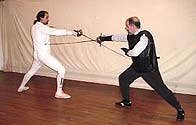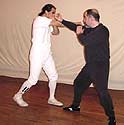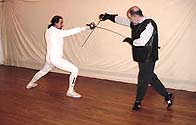It's All in the Timing:
Concepts of Combative Timing in Historical Italian Swordsmanship
By Ken Mondschein
Timing, it is said, is everything. Sun Tzu, writing his "Art of
War" in the time of China's Zhou dynasty, spoke of when it is advantageous
to strike at the enemy, and when it is advantageous to wait. On a smaller
scale, seizing the opportune moment in which to strike the adversary,
or, consequently, thwarting the adversary's own attempts to strike oneself,
is an integral part of any martial art. And, in keeping with the endless
classification and analysis characteristic of Western thinking, European
systems of fencing have a very sophisticated vocabulary with which to
describe timing. These conceptions, which give names to practices found
within the fighting systems of many nations, will no doubt found to be
a useful training tool, as well as a spur to martial creativity. Indeed,
in his "Tao of Jeet Kune Do," Bruce Lee's concept of the "intercepting
fist" was highly influenced by his study of fencing. A study of timing
may also aid judges in martial arts competitions, who may begin to better
recognize and give credit to various types of counters to attacks thereby.
This article therefore intends to explain conceptions of timing found
in one tradition of Western swordsmanship, the Italian schools of rapier
fencing that existed in the early modern era, in a way that will be useful
and accessible to practitioners of all martial arts. The reason why we
have chosen the rapier to illustrate these concepts is that this particular
weapon is a long, relatively slow thrust-and-cut sword that necessitates
a sophisticated sense of timing for its effective use. Later in the history
of fencing in Italy, the weapons grew lighter and quicker, and the definitions
changed somewhat to reflect these new realities.
The concepts of fencing time ("tempo schermistico") found in
Italian rapier are several: "stesso tempo", or "single
(literally, "self") time;" "dui tempi," or "double
time;" "mezzo tempo," or "in the middle of the time,"
the action made "in tempo," or "in time," and "contratempo,"
"counter-time," or "against the time." It is important
to note that these concepts of "fencing time" ("tempo schermistico"
in the singular, or "tempi schermistici" in the plural) are
not the same as the concept of "tempo," which may be translated
as "timing." Timing, of course is an acquired sensibility as
to the appropriate moment to execute any given technique.
These ideas of timing have a long history. For instance, Marcelli, in
his treatise of 1686, says (translated): "Time may be considered
in three ways: In the first time, or time of the first intention; in absolute
time; and in time of second intention, or double time." That is,
stesso tempo, mezzo tempo, and dui tempi. He later goes on to speak of
"another, most delicate action... striking in countertime."
The reader may also note that we seem to be speaking of "fencing
time" as if one fencing time was a concrete, quantifiable, and invariable
period. This is not the case. One fencing time is a relative, not absolute
thing. It is defined simply as "the time it takes to perform one
fencing action." Thus, a lunge with the rapier is one time, a direct
cut with the edge is one time, a parry against the lunge or cut is one
time, and a step forwards or backwards is one time. Of course, actions
can be combined, so a step backwards taken together with a parry, or the
extension of the arm which is an integral part of the lunge, is still
one time.
By extension of this principle, it also takes one time to jab with a
fist, one time to throw a roundhouse kick, or one time to unbalance an
opponent in judo. In terms of "clock time," it is of course
not the case that everyone's roundhouse kick travels at the same speed,
and, likewise, we know that a jab, relatively speaking, is faster than
a roundhouse kick. However, they are all alike in that they are single,
simple actions, and so, for the purpose of our discussion, which concerns
the tactical use of "timing" and not the measuring of "time,"
we shall consider them the same.
Given the definition of what one fencing time is, it is easy to understand
the concept of "dui tempi," that is, "two times."
This is, quite simply, one simple action followed by another. Thus, a
parry followed by a riposte (that is, a counterattack) is considered "dui
tempi," a block followed by a punch is likewise two times; and a
defense against a throw followed by an attempt to counter-throw can be
seen as two times. Two jabs thrown in quick succession is two times; likewise,
a jab followed by a reverse punch is also two times. Again, the relative
speed of the actions is not important; what is important is that they
are two discreet actions, whether offensive, defensive, or a combination
of both. This is the most elementary mode of offense or defense: One attacks,
and then one defends; or, conversely, one defends, and then one attacks.
Below two action sequences illustrate "dui tempi" timing. In
the first series Maestro Martinez parries Ken's cut to his head and then
responds with a cut of his own. In the second, unarmed sequence, in response
to Ken's reverse punch, Maestro Martinez first blocks the attack, and
then simultaneously checks Ken's arm and strikes.
(Click pictures for animation)
Considered offensively, however, "dui tempi" uses time as a
weapon. As Sun Tzu says, "All warfare is based on deception."
Thus, a fencer may threaten the opponent with a feigned strike to the
head (that is, a feint), and, as he raises his blade to defend himself,
deceive the parry and cut him in the flank. In karate point-fighting,
one deceives by threatening a backfist (uraken) to the head, and, as the
opponent raises his hands to defend, launches a sidekick (yoko geri) to
the stomach. In semi- or full- contact fighting, a jab can be the set-up
for a devastating reverse punch. In judo, one unbalances an opponent in
one direction, and, when he compensates, unbalances him in the other direction
as a set-up to the throw.
This is the principle of the feint, which those considered "natural
fighters" grasp instinctively. The rest of us, however, may benefit
from some analytical study. The most important element is that "the
feint must be made with absolute conviction," forcing the opponent
to react. As he reacts, the strike is made in the space uncovered. Likewise,
the false attack must always be able to transform instantly into a real
one, in case no reaction is provoked. One can instantly recognize the
value of certain Zen concepts, such as the emphasis placed on the tranquil,
immovable mind, in not overreacting to feints and making the adversary's
job easier. The feint is indeed a difficult art to master, and one requiring
years of practice, as well as great mental acuity.
Defensively, "mezzo tempo," or "in the middle of the time,"
is more sophisticated than the simple parry/riposte or block/punch. It
is an extremely useful concept, but it requires training, as it utilizes
a more finely developed sense of timing and tactics than "dui tempi."
In rapier fencing, one may use a "mezzo tempo" action against
a cut by lunging and striking the opponent with a thrust as he raises
his arm to strike. Or, if the adversary makes a feint to the face followed
by an attack to the abdomen, one may likewise act in the middle of his
time, lunging at the instant he begins to lower his point, hitting him
before the actual attack can develop.
In a Filipino martial art, a quick blow to the fingers of an opponent
who is trying to strike with a stick may be seen as a "mezzo tempo"
action. In karate, one can defend against a roundhouse kick using a time
action by stepping in as the kick is thrown and delivering a jab or side-thrust
punch (jun tsuki) to knock the opponent back and rob the kick of its power.
Two pugilistic defenses making use of time actions against a hook punch
are throwing a quick counterpunch against the shoulder of the opponent,
and stepping in with a rising elbow to the chin (jodan hiji-ate), taking
the punch on the arm.
Two action sequences below illustrate "mezzo tempo" timing.
In the first Maestro Martinez responds to Ken's flank cut with a quicker
thrust in "mezzo tempo." In the next, unarmed sequence, Ken
sets up a roundhouse kick, but Maestro Martinez closes in, striking before
the kick can be developed.
(Click pictures for animation)
The astute reader will notice that all of the aforesaid "mezzo tempo"
actions require either moving in, throwing a quicker counter-technique,
or both. Unlike a "dui tempi" defense, one does not wait for
the opponent to finish his attack before countering; rather, one makes
a proactive defense by not allowing the opponent to finish his attack.
The downside to this, of course, is that if the maneuver is performed
incorrectly, one winds up stepping into the oncoming attack. Continually
stepping into attacks, or, for that matter, fearfully striking out as
an instinctive reaction at having an attack made at oneself, is neither
skillful, nor particularly wise.
Perhaps the hardest of all these concepts of timing to explain and perform,
but also perhaps the most elegant and effective, is the concept of "stesso
tempo," in which defense and offense become one. Because of its relative
slowness, a "dui tempi" response to an attack with the rapier
would take an impractically long time, allowing the opponent time to perform
a counter. Therefore, historical masters such as Fabris advised fencers
of early modern era to defend themselves and wound the adversary "in
stesso tempo" with an intercepting attack, an action both defensive
and offensive. One way to do this with the single rapier is to catch the
opponent's thrust in such a manner that the point is diverted with the
portion of one's own rapier nearest the guard, while one's own point was
directed against the adversary's target. One's own target, meanwhile,
is further removed from danger with an evasive body movement. This is
a technique that requires a sure sense of distance and timing, as well
as a mastery of technique, great sensitivity, and a sure hand.
However, a "stesso tempo" action need not be made solely with
the weapon. Another way of defending and offending in "stesso tempo"
would be to deflect the oncoming attack with the left-hand dagger that
was often the rapier's companion, while simultaneously executing a body
displacement and counter thrust with one's own rapier. One may also attack
with the single rapier or rapier and dagger in "stesso tempo"
against a "dui tempi" feint and attack, defending oneself and
offending in the same time -- while the opponent feints, you hit. Needless
to say, incorrectly performing a "stesso tempo" action can be
disastrous.
In the action sequences below Maestro Martinez counters Ken's lunge with
a counter thrust in "stesso tempo."

(Click picture for animation)
An example of a "stesso tempo" action in unarmed fighting might
be to deflect a hooking punch to the head with a jab delivered in such
a manner as to both deflect the punch and strike the attacker. Another
would be to partially deflect a punch to the body with one hand, while
at the same time displacing one's body and driving home a counter punch
with a step forty-five degrees forward. However, the close distance and
relative quickness involved in empty-handed fighting can make these sorts
of maneuvers extremely challenging to perform.
In the action sequence below Ken attempts a reverse punch, but Maestro
Martinez simultaneously deflects the oncoming attack and strikes with
a counter punch in "stesso tempo."

(Click picture for animation)
Time actions, or actions made "in tempo" ("in time"),
are another method of manipulating moments in time to defend oneself and
offend the opponent. A counterattack made "in tempo" may perhaps
best be understood by the example of the stop-hit, or "colpo di arresto."
For example, as the opponent lunges with a sword thrust to the knee, one
can merely draw one's leg back, lower the point of one's own sword, and
transfix his wrist. The same with karate: As an opponent lunges forward
with a backfist, draw back and launch a sidekick into the unprotected
flank. The "colpo di arresto," in short, is a counteroffensive
movement made in the same time as the attack, together with a body evasion
that removes the target from reach.
In the first action sequence below Maestro Martinez executes a stop against
Ken's cut to his leg, with body displacement. In the unarmed sequence,
in response to Ken's reverse punch, Maestro Martinez again displaces his
body and makes a hit "in tempo."
(Click pictures for animation)
Marcelli is correct in calling counter time "most delicate,"
for an improperly executed counter time tactic results in both combatants
being struck -- a pyrrhic victory at best. One does not trade blow-for-blow
with sharp swords. Contratempo, or "counter-time," is intimately
linked with the colpo di arresto." "Contratempo" is an
action against the adversary's stop. "Contratempo" may also
be used against the fearful opponent who strikes out blindly in response
to any attack. A counterattack may be provoked with a false attack, and
then exploited in "contratempo." With the aforesaid example
of the stop-hit against the attack to the leg, the fencer attacking his
opponent's knee may stop his attack short, bind his opponent's blade,
and strike him in the face. Likewise, a savvy karate-ka, aware that the
opponent tends to counter-kick, may avoid the kick by a block or sudden
change of direction and continue the attack. At this point, the contest
comes down to who has the greater skill, experience, subtlety of movement,
and presence of mind.
In the action sequnce below Ken makes a false attack, drawing Maestro
Martinezí stop, and then binds the blade and strikes.

(Click for animation)
To conclude, the concepts of timing found in the Italian school of fencing
provide a convenient and useful framework for considering and practicing
offensive and defensive tactics in a variety of situations. We hope that
readers have found this article useful, and that it aids them in their
own development, no matter what art they study.
About The Author
Ken Mondschein is a New York City writer, amateur historian and Associate
Editor for European Sword Arts at FightingArts.com. After achieving a
masters degree in European History he became a student of classical fencing
and historical swordsmanship under Maestro Ramon Martinez. He is also
knowledgeable about European classical dressage, the art of horsemanship,
and its history and application in mounted combat. Other martial arts
studies include karate where he is now a student at the World Seido Karate
Organization's New York City headquarters. Mondschein currently works
in textbook publishing.
The author is grateful to his own teachers, Maestro Ramon Martinez and
Maestro Jeannette Acosta-Martinez of the Martinez Academy of Arms, for
not only introducing him to the Italian school of fencing and nurturing
him therein, but also for proofreading this article and guiding its writing.
The author must no less acknowledge Kaicho Tadashi Nakamura and the World
Seido Karate Organization which have guided his development both as a
karate-ka and as a human being.
|